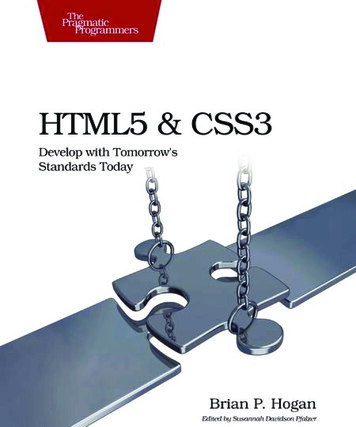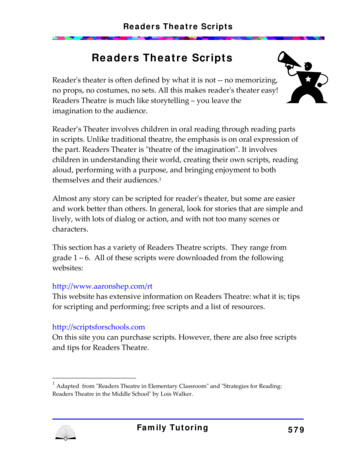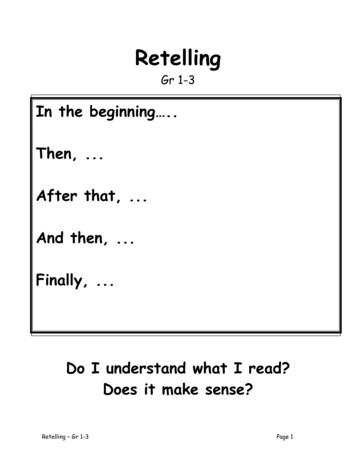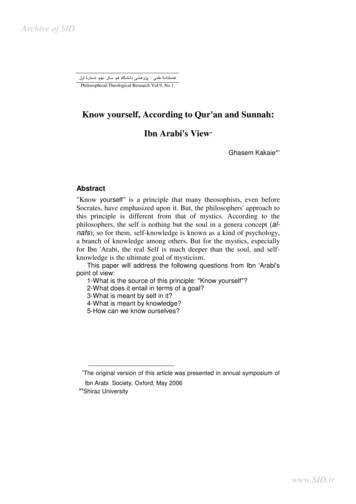
Transcription
What Readers Are Saying About HTML5 and CSS3This book does an excellent job of cutting through the hype and tellingyou what you need to know to navigate the HTML5 waters.Casey HelblingFounder, Clear :: Software for GoodIf you are looking to take advantage of the emerging HTML5 standard,then this is your book. Brian’s practical experience and examplesshow you how to develop robust web applications amid all the supportdifferences of today’s browsers.Mark NicholsMicrosoft Senior consultant and cohost,DeveloperSmackdown.com PodcastLearning HTML5 and CSS3 has improved my ability to work oncutting-edge projects. I just started a project using HTML5, and Iwould not have felt confident without this book.Noel RappinSenior consultant, Obtiva, and author, Rails Test PrescriptionsBrian’s book effortlessly guides you through crafting a site in HTML5and CSS3 that works in all browsers; it describes what works now,what doesn’t, and what to watch out for as the standards andbrowsers evolve.Doug RhotenSenior software developer, InterFlow
HTML5 and CSS3Develop with Tomorrow’s Standards TodayBrian P. HoganThe Pragmatic BookshelfRaleigh, North CarolinaDallas, Texas
Many of the designations used by manufacturers and sellers to distinguish their products are claimed as trademarks. Where those designations appear in this book, and ThePragmatic Programmers, LLC was aware of a trademark claim, the designations havebeen printed in initial capital letters or in all capitals. The Pragmatic Starter Kit, ThePragmatic Programmer, Pragmatic Programming, Pragmatic Bookshelf and the linking gdevice are trademarks of The Pragmatic Programmers, LLC.Every precaution was taken in the preparation of this book. However, the publisherassumes no responsibility for errors or omissions, or for damages that may result fromthe use of information (including program listings) contained herein.Our Pragmatic courses, workshops, and other products can help you and your teamcreate better software and have more fun. For more information, as well as the latestPragmatic titles, please visit us at http://www.pragprog.com.The team that produced this book includes:Editor:Indexing:Copy edit:Layout:Production:Customer support:International:Susannah PfalzerPotomac Indexing, LLCKim WimpsettSteve PeterJanet FurlowEllie CallahanJuliet BendaCopyright 2010 Pragmatic Programmers, LLC.All rights reserved.No part of this publication may be reproduced, stored in a retrieval system, or transmitted, in any form, or by any means, electronic, mechanical, photocopying, recording, orotherwise, without the prior consent of the publisher.Printed in the United States of America.ISBN-10: 1-934356-68-9ISBN-13: 978-1-934356-68-5Printed on acid-free paper.P1.0 printing, December 2010Version: 2011-1-4
ContentsAcknowledgmentsPrefaceHTML5: The Platform vs. the SpecificationHow This Works . . . . . . . . . . . . . . . .What’s in This Book . . . . . . . . . . . . .Prerequisites . . . . . . . . . . . . . . . . . .Online Resources . . . . . . . . . . . . . . .18.101011121213An Overview of HTML5 and CSS31.1A Platform for Web Development . . . . . . . . . .1.2Backward Compatibility . . . . . . . . . . . . . . .1.3The Road to the Future Is Bumpy . . . . . . . . .14141717.Part I—Improving User Interfaces232New Structural Tags and AttributesTip 1 Redefining a Blog Using Semantic Markup . . . .Tip 2 Creating Pop-up Windows with Custom Data Attributes . . . . . . . . . . . . . . . . . . . . . . . . . .2427Creating User-Friendly Web FormsTip 3 Describing Data with New Input Fields . .Tip 4 Jumping to the First Field with Autofocus .Tip 5 Providing Hints with Placeholder Text . . .Tip 6 In-Place Editing with contenteditable . . .45485658653.40
CONTENTS45MakingTip 7Tip 8Tip 9Tip 10Better User Interfaces with CSS3Styling Tables with Pseudoclasses . . . . . . . .Making Links Printable with :after and content .Creating Multicolumn Layouts . . . . . . . . . .Building Mobile Interfaces with Media Queries .7274838794Improving AccessibilityTip 11 Providing Navigation Hints with ARIA Roles . . . .Tip 12 Creating an Accessible Updatable Region . . . . .9799104Part II—New Sights and Sounds1106Drawing on the CanvasTip 13 Drawing a Logo . . . . . . . . . . . . . . . . . . . .Tip 14 Graphing Statistics with RGraph . . . . . . . . . .1111121197Embedding Audio and Video7.1A Bit of History . . . .7.2Containers and CodecsTip 15 Working with Audio . .Tip 16 Embedding Video . . .1271281291331378.Eye CandyTip 17 Rounding Rough EdgesTip 18 Working with Shadows,mations . . . . . . . . . .Tip 19 Using Real Fonts . . . . . . . . . . . . . . . . . .Gradients, and Transfor. . . . . . . . . . . . . . . . . . . . . . . . . . . . .144146154165Part III—Beyond HTML51719Working with Client-Side DataTip 20 Saving Preferences with localStorage . . . . . . . .Tip 21 Storing Data in a Client-Side Relational DatabaseTip 22 Working Offline . . . . . . . . . . . . . . . . . . . .17217518119310Playing Nicely with Other APIsTip 23 Preserving History . . . . . . .Tip 24 Talking Across Domains . . .Tip 25 Chatting with Web Sockets .Tip 26 Finding Yourself: Geolocation196197200207214.Report erratumthis copy is (P1.0 printing, December 2010)6
CONTENTS11AWhere11.111.211.311.411.511.611.7to Go NextCSS3 Transitions . . . . . . . .Web Workers . . . . . . . . . . .Native Drag-and-Drop SupportWebGL . . . . . . . . . . . . . .Indexed Database API . . . . .Client-Side Form Validation . .Onward! . . . . . . . . . . . . 238238PrimerLoading jQuery . . . . . . .jQuery Basics . . . . . . . .Methods to Modify ContentCreating Elements . . . . .Events . . . . . . . . . . . .Document Ready . . . . . .240240241241244244245CEncoding Audio and VideoC.1Encoding Audio . . . . . . . . . . . . . . . . . . . .C.2Encoding Video for the Web . . . . . . . . . . . . .247247248DResourcesD.1Resources on the Web . . . . . . . . . . . . . . . .249249EBibliography251Index252BFeatures Quick ReferenceA.1New Elements . . . .A.2Attributes . . . . . .A.3Forms . . . . . . . . .A.4Form Field AttributesA.5Accessibility . . . . .A.6Multimedia . . . . . .A.7CSS3 . . . . . . . . .A.8Client-Side Storage .A.9Additional APIs . . .jQueryB.1B.2B.3B.4B.5B.6.Report erratumthis copy is (P1.0 printing, December 2010)7
AcknowledgmentsI jumped into writing this book before I had even finished my previousone, and although most of my friends, family, and probably the publisher thought I was crazy for not taking a bit of a break, they haveall been so supportive. This book is a result of so many wonderful andhelpful people.First, I can’t thank Dave Thomas and Andy Hunt enough for givingme the opportunity to work with them a second time. Their feedbackthroughout this process has helped shape this book quite a bit, andI’m honored to be a Pragmatic Bookshelf author.Daniel Steinberg helped me get this book started, signed, and on theright track early on, and I’m very grateful for all the support he gaveand the things he taught me about how to write clearly. Whenever Iwrite, I still hear his voice guiding me in the right direction.Daniel was unable to continue working with me on this book, but heleft me in unbelievably good hands. Susannah Pfalzer has been soamazingly helpful throughout this entire process, keeping me on track,pushing me to do better, and always knowing exactly the right questions to ask me at exactly the right times. Without Susannah, this bookwouldn’t be nearly as good.My technical reviewers for both rounds were extremely helpful in shaping a lot of the content and its presentation. Thank you, Aaron Godin,Ali Raza, Charles Leffingwell, Daniel Steinberg, David Kulberg, DonHenton, Doug Rhoten, Edi Schlechtinger, Jon Mischo, Jon Oebser,Kevin Gisi, Marc Harter, Mark Nichols, Noel Rappin, Paul Neibarger,Sam Elliott, Sean Canton, Srdjan Pejic, Stephen Wolff, Todd Dahl, andErik Watson.
A CKNOWLEDGMENTSSpecial thanks to the fine folks at ZenCoder for assisting with the videoencoding for the sample files and for making it much easier for contentproducers to prepare video for HTML5.Thank you to my business associates Chris Johnson, Chris Warren,Mike Weber, Jon Kinney, Adam Ludwig, Gary Crabtree, Carl Hoover,Josh Anderson, Austen Ott, and Nick Lamuro for the support on thisand many other projects. Special thanks to Erich Tesky for the realitychecks and for being a great friend when things got frustrating.I also want to thank my dad for always expecting me to do my best andfor pushing me to not give up when things looked impossible. That’smade anything possible.Finally, my wonderful wife, Carissa, and my daughters, Ana and Lisa,have my eternal gratitude and love. They gave up a lot of weekendsand evenings so that I could hammer away in the office writing. Everytime I got stuck, Carissa’s constant reassurance that I’d “figure it out”always seemed to make it better. I am extremely lucky to have them inmy corner.Report erratumthis copy is (P1.0 printing, December 2010)9
PrefaceThree months on the Web is like a year in real time.Web developers pretty much think this way, since we’re always hearingabout something new. A year ago HTML5 and CSS3 seemed so far offin the distance, but already companies are using these technologies intheir work today, because browsers like Google Chrome, Safari, Firefox,and Opera are starting to implement pieces of the specification.HTML5 and CSS3 help lay the groundwork for the next generation ofweb applications. They let us build sites that are simpler to develop,easier to maintain, and more user-friendly. HTML5 has new elementsfor defining site structure and embedding content, which means wedon’t have to resort to extra markup or plug-ins. CSS3 provides advanced selectors, graphical enhancements, and better font support thatmakes our sites more visually appealing without using font image replacement techniques, complex JavaScript, or graphics tools. Improvedaccessibility support will improve Ajax applications for people with disabilities, and offline support lets us start building working applicationsthat don’t need an Internet connection.In this book, you’re going to find out about all of the ways you can useHTML5 and CSS3 right now, even if your users don’t have browsersthat can support all of these features yet. Before we get started, let’stake a second and talk about HTML5 and buzzwords.HTML5: The Platform vs. the SpecificationHTML5 is a specification that describes some new tags and markup, aswell as some wonderful JavaScript APIs, but it’s getting caught up ina whirlwind of hype and promises. Unfortunately, HTML5 the standardhas evolved into HTML5 the platform, creating an awful lot of confusionamong developers, customers, and even authors. In some cases, pieces
H OW T HIS W ORKSfrom the CSS3 specification such as shadows, gradients, and transformations are being called “HTML.” Browser makers are trying to one-upeach other with how much “HTML5” they support. People are startingto make strange requests like “My site will be in HTML5, right?”For the majority of the book, we’ll focus on the HTML5 and CSS3 specifications themselves and how you can use the techniques they describe.In the last part of the book, we’ll look into a suite of closely relatedspecifications that were once part of HTML5 but are in use right nowon multiple platforms. These include Web SQL Databases, Geolocation,and Web Sockets. Although these things aren’t technically HTML5, theycan help you build incredible things when combined with HTML5 andCSS3.How This WorksEach chapter in this book focuses on a specific group of problems thatwe can solve with HTML5 and CSS3. Each chapter has an overviewand a table summarizing the tags, features, or concepts covered in thechapter. The main content of each chapter is broken apart into “tips,”which introduce you to a specific concept and walk you through building a simple example using the concept. The chapters in this book aregrouped topically. Rather than group things into an HTML5 part and aCSS3 part, it made more sense to group them based on the problemsthey solve.Each tip contains a section called “Falling Back,” which shows youmethods for addressing the users who use browsers that don’t offerHTML5 and CSS3 support. We’ll be using a variety of techniques tomake these fallbacks work, from third-party libraries to our own jQueryplug-ins. These tips can be read in any order you like.Finally, each chapter wraps up with a section called “The Future,”where we discuss how the concept can be applied as it becomes morewidely adopted.This book focuses on what you can use today. There are more HTML5and CSS3 features that aren’t in widespread use yet. You’ll learn moreabout them in the final chapter, Chapter 11, Where to Go Next, onpage 218.Report erratumthis copy is (P1.0 printing, December 2010)11
W HAT ’ S IN T HIS B OOKWhat’s in This BookWe’ll start off with a brief overview of HTML5 and CSS3 and take a lookat some of the new structural tags you can use to describe your pagecontent. Then we’ll work with forms, and you’ll get a chance to use someof the form fields and features such as autofocus and placeholders.From there, you’ll get to play with CSS3’s new selectors so you canlearn how to apply styles to elements without adding extra markup toyour content.Then we’ll explore HTML’s audio and video support, and you’ll learnhow to use the canvas to draw shapes. You’ll also get to see how touse CSS3’s shadows, gradients, and transformations, as well as how tolearn how to work with fonts.In the last section, we’ll use HTML5’s client-side features such as WebStorage, Web SQL Databases, and offline support to build client-sideapplications. We’ll use Web Sockets to talk to a simple chat service,and you’ll see how HTML5 makes it possible to send messages and dataacross domains. You’ll also get a chance to play with the GeolocationAPI and learn how to manipulate the browser’s history. We’ll then wrapup by taking a look at a few things that aren’t immediately useful butwill become important in the near future.In Appendix A, on page 232, you’ll find a listing of all the features covered in this book with a quick reference to those chapters that reference those features. We’ll be using a lot of jQuery in this book, soAppendix B, on page 240, gives you a short primer. You’ll also find asmall appendix explaining how to encode audio and video files for usewith HTML5.PrerequisitesThis book is aimed primarily at web developers who have a good understanding of HTML and CSS. If you’re just starting out, you’ll still findthis book valuable, but I recommend you check out Designing with WebStandards [Zel09] and my book, Web Design for Developers [Hog09].I also assume that you have a basic understanding of JavaScript andjQuery,1 which we will be using to implement many of our fallback1.http://www.jquery.comReport erratumthis copy is (P1.0 printing, December 2010)12
O NLINE R ESOURCESsolutions. Appendix B, on page 240, is a brief introduction to jQuerythat covers the basic methods we’ll be using.You’ll need Firefox 3.6, Google Chrome 5, Opera 10.6, or Safari 5 totest the code in this book. You’ll probably need all of these browsers totest everything we’ll be building, since each browser does things a littledifferently.You’ll also need a way to test your sites with Internet Explorer so youcan ensure that the fallback solutions we create actually work. If youneed to be able to test your examples in multiple versions of InternetExplorer, you can download IETester for Windows, because it supportsIE 6, 7, and 8 in a single application. If you’re not running Windows,you should consider using a virtual machine like VirtualBox or VMwareor using a service like CrossBrowserTesting2 or MogoTest.3Online ResourcesThe book’s website4 has links to an interactive discussion forum aswell as errata for the book. You can also find the source code for all theexamples in this book linked on that page. Additionally, readers of theeBook can click on the gray box above the code excerpts to downloadthat snippet directlyIf you find a mistake, please create an entry on the Errata page so wecan get it addressed. If you have an electronic copy of this book, thereare links in the footer of each page that you can use to easily submiterrata.Finally, be sure to visit this book’s blog, Beyond HTML5 and CSS3.5 I’llbe posting related material, updates, and working examples from thisbook.Ready to go? Great! Let’s get started with HTML5 and hh5/http://www.beyondhtml5andcss3.com/Report erratumthis copy is (P1.0 printing, December 2010)13
Chapter 1An Overview of HTML5 and CSS3HTML51 and CSS32 are more than just two new standards proposed bythe World Wide Web Consortium (W3C) and its working groups. Theyare the next iteration of technologies you use every day, and they’rehere to help you build better modern web applications. Before we diveinto the deep details of HTML5 and CSS3, let’s talk about some benefitsof HTML5 and CSS3, as well as some of the challenges we’ll face.1.1 A Platform for Web DevelopmentA lot of the new features of HTML center around creating a betterplatform for web-based applications. From more descriptive tags andbetter cross-site and cross-window communication to animations andimproved multimedia support, developers using HTML5 have a lot ofnew tools to build better user experiences.More Descriptive MarkupEach version of HTML introduces some new markup, but never beforehave there been so many new additions that directly relate to describing content. You’ll learn about elements for defining headings, footers,navigation sections, sidebars, and articles in Chapter 2, New Structural Tags and Attributes, on page 24. You’ll also learn about meters,progress bars, and how custom data attributes can help you mark updata.The HTML5 specification is at http://www.w3.org/TR/html5/.CSS3 is split across multiple modules, and you can follow its progress athttp://www.w3.org/Style/CSS/current-work.1.2.
A P LATFORM FOR W EB D EVELOPMENTMultimedia with Less Reliance on Plug-insYou don’t need Flash or Silverlight for video, audio, and vector graphics anymore. Although Flash-based video players are relatively simpleto use, they don’t work on Apple’s mobile devices. That’s a significantmarket, so you’ll need to learn how to use non-Flash video alternatives.In Chapter 7, Embedding Audio and Video, on page 127, you’ll see howto use HTML5 audio and video with effective fallbacks.Better ApplicationsDevelopers have tried all kinds of things to make richer, more interactive applications on the Web, from ActiveX controls to Flash. HTML5offers amazing features that, in some cases, completely eliminate theneed for third-party technologies.Cross-Document MessagingWeb browsers prevent us from using scripts on one domain to affector interact with scripts on another domain. This restriction keeps endusers safe from cross-site scripting, which has been used to do all sortsof nasty things to unsuspecting site visitors.However, this prevents all scripts from working, even when we writethem ourselves and know we can trust the content. HTML5 includes aworkaround that is both safe and simple to implement. You’ll see howto make this work in Talking Across Domains, on page 200.Web SocketsHTML5 offers support for Web Sockets, which give you a persistentconnection to a server. Instead of constantly polling a back end forprogress updates, your web page can subscribe to a socket, and theback end can push notifications to your users. We’ll play with that a bitin Chatting with Web Sockets, on page 207.Client-Side StorageWe tend to think of HTML5 as a web technology, but with the addition ofthe Web Storage and Web SQL Database APIs, we can build applicationsin the browser that can persist data entirely on the client’s machine.You’ll see how to use those APIs in Chapter 9, Working with Client-SideData, on page 172.Report erratumthis copy is (P1.0 printing, December 2010)15
A P LATFORM FOR W EB D EVELOPMENTBetter InterfacesThe user interface is such an important part of web applications, andwe jump through hoops every day to make browsers do what we want.To style a table or round corners, we either use JavaScript librariesor add tons of additional markup so we can apply styles. HTML5 andCSS3 make that practice a thing of the past.Better FormsHTML5 promises better user interface controls. For ages, we’ve beenforced to use JavaScript and CSS to construct sliders, calendar datepickers, and color pickers. These are all defined as real elements inHTML5, just like drop-downs, checkboxes, and radio buttons. You’lllearn about how to use them in Chapter 3, Creating User-Friendly WebForms, on page 45. Although this isn’t quite ready yet for every browser,it’s something you need to keep your eye on, especially if you developweb-based applications. In addition to improved usability without reliance on JavaScript libraries, there’s another benefit—improved accessibility. Screen readers and other browsers can implement these controls in specific ways so that they work easily for the disabled.Improved AccessibilityUsing the new HTML5 elements in HTML5 to clearly describe our content makes it easier for programs like screen readers to easily consumethe content. A site’s navigation, for example, is much easier to find ifyou can look for the nav tag instead of a specific div or unordered list.Footers, sidebars, and other content can be easily reordered or skippedaltogether. Parsing pages in general becomes much less painful, whichcan lead to better experiences for people relying on assistive technologies. In addition, new attributes on elements can specify the roles ofelements so that screen readers can work with them easier. In Chapter 5, Improving Accessibility, on page 97, you’ll learn how to use thosenew attributes so that today’s screen readers can use them.Advanced SelectorsCSS3 has selectors that let you identify odd and even rows of tables, allselected check boxes, or even the last paragraph in a group. You canaccomplish more with less code and less markup. This also makes itmuch easier to style HTML you can’t edit. In Chapter 4, Making Better User Interfaces with CSS3, on page 72, you’ll see how to use theseselectors effectively.Report erratumthis copy is (P1.0 printing, December 2010)16
B ACKWARD C OMPATIBILITYVisual EffectsDrop shadows on text and images help bring depth to a web page, andgradients can also add dimension. CSS3 lets you add shadows andgradients to elements without resorting to background images or extramarkup. In addition, you can use transformations to round corners orskew and rotate elements. You’ll see how all of those things work inChapter 8, Eye Candy, on page 144.1.2Backward CompatibilityOne of the best reasons for you to embrace HTML5 today is that itworks in most existing browsers. Right now, even in Internet Explorer6, you can start using HTML5 and slowly transition your markup. It’lleven validate with the W3C’s validation service (conditionally, of course,because the standards are still evolving).If you’ve worked with HTML or XML, you’ve come across the doctypedeclaration before. It’s used to tell validators and editors what tags andattributes you can use and how the document should be formed. It’salso used by a lot of web browsers to determine how the browser willrender the page. A valid doctype often causes browsers to render pagesin “standards mode.”Compared to the rather verbose XHTML 1.0 Transitional doctype usedby many sites: !DOCTYPE html PUBLIC "-//W3C//DTD XHTML 1.0 xhtml1-transitional.dtd" the HTML5 doctype is ridiculously simple:Download html5 why/index.html !DOCTYPE html Place that at the top of the document, and you’re using HTML5.Of course, you can’t use any of the new HTML5 elements that yourtarget browsers don’t yet support, but your document will validate asHTML5.1.3 The Road to the Future Is BumpyThere are a few roadblocks that continue to impede the widespreadadoption of HTML5 and CSS3. Some are obvious, and some are less so.Report erratumthis copy is (P1.0 printing, December 2010)17
T HE R OAD TO THE F UTURE I S B UMPYJoe Asks. . .But I Like My XHTML Self-Closing Tags. Can I Still Use Them?You sure can! Many developers fell in love with XHTML becauseof the stricter requirements on markup. XHTML documentsforced quoted attributes, made you self-close content tags,required that you use lowercase attribute names, and broughtwell-formed markup onto the World Wide Web. Moving toHTML5 doesn’t mean you have to change your ways. HTML5documents will be valid if you use the HTML5-style syntax or theXHTML syntax, but you need to understand the implications ofusing self-closing tags.Most web servers serve HTML pages with the text/html MIMEtype because of Internet Explorer’s inability to properly handle the application/xml xhtml MIME type associated with XHTMLpages. Because of this, browsers tend to strip off self-closingtags because self-closing tags were not considered valid HTMLbefore HTML5. For example, if you had a self-closing script tagabove a div like this: script language "javascript" src "application.js" / h2 Help /h2 the browser would remove the self-closing forward slash, andthen the renderer would think that the h2 was within the scripttag, which never closes! This is why you see script tags codedwith an explicit closing tag, even though a self-closing tag isvalid XHTML markup.So, be aware of possible issues like this if you do use selfclosing tags in your HTML5 documents, because they will beserved with the text/html MIME type. You can learn moreabout this issue and others at myths.Report erratumthis copy is (P1.0 printing, December 2010)18
T HE R OAD TO THE F UTURE I S B UMPYCake and FrostingI like cake. I like pie better, but cake is pretty good stuff. I prefercake with frosting on it.When you’re developing web applications, you have to keepin mind that all the pretty user interfaces and fancy JavaScriptstuff is the frosting on the cake. Your website can be really goodwithout that stuff, and just like a cake, you need a foundationon which to put your frosting.I’ve met some people who don’t like frosting. They scrape itoff the cake. I’ve also met people who use web applicationswithout JavaScript for varying reasons.Bake these people a really awesome cake. Then add frosting.Internet ExplorerInternet Explorer currently has the largest user base, and versions 8and below have very weak HTML5 and CSS3 support. IE 9 improves thissituation, but it’s not widely used yet. That doesn’t mean we can’t useHTML5 and CSS3 in our sites anyway. We can make our sites work inInternet Explorer, but they don’t have to work the same as the versionswe develop for Chrome and Firefox. We’ll just provide fallback solutionsso we don’t anger users and lose customers.AccessibilityOur users must be able to interact with our websites, whether they arevisually impaired, hearing impaired, on older browsers, on slow connections, or on mobile devices. HTML5 introduces some new elements,such as audio, video, and canvas. Audio and video have always hadaccessibility issues, but the canvas element presents new challenges.The canvas element lets us create vector images within the HTML document using JavaScript. This creates issues for the visually impaired butalso causes problems for the 5 percent of web users who have Report erratumthis copy is (P1.0 printing, December 2010)19
T HE R OAD TO THE F UTURE I S B UMPYWe need to be mindful of accessibility when we push ahead with newtechnologies and provide suitable fallbacks for these HTML5 elements,just like we would for people using Internet Explorer.Deprecated TagsHTML5 has introduced a lot of new elements, but the specification alsodeprecates quite a few common elements that you might find in yourweb pages.4 You’ll want to remove those moving forward.First, several presentational elements are gone. If you find these in yourcode, get rid of them! Replace them with semantically correct elementsand use CSS to make them look nice. basefont big center font s strike tt uSome of those tags are pretty obscure, but you will find a lot of pagesout there maintained with visual editors such as Dreamweaver that stillcontain a lot of font and center tags.Aside from the presentational elements, support for frames has beenremoved. Frames have always been popular in enterprise web applications such as PeopleSoft, Microsoft Outlook Web Access, and evencustom-built portals. Despite the widespread use, frames caused somany usability and accessibility issues that they just had to go. Thatmeans these elements are gone: frame frameset noframesYou should be looking at ways to lay out your interfaces without frames,using regular CSS or some JavaScript. If you’re using frames to ensurethe same header, footer, and navigation appears on each page of your4.http://www.w3.org/TR/html5-diff/Report erratumthis copy is (P1.0 printing, December 2010)20
T HE R OAD TO THE F UTURE I S B UMPYapplication, you should be able to accomplish the same thing with thetools provided by your web development framework. A few other elements are gone
Jan 04, 2011 · What Readers Are Saying About HTML5 and CSS3 This book does an excellent job of cutting through the hype and telling you what you need to know to navigate the HTML5 waters. Casey Helbling Founder, Clear :: Software for Good If you are looking to take advantage of the emerging HTML5










